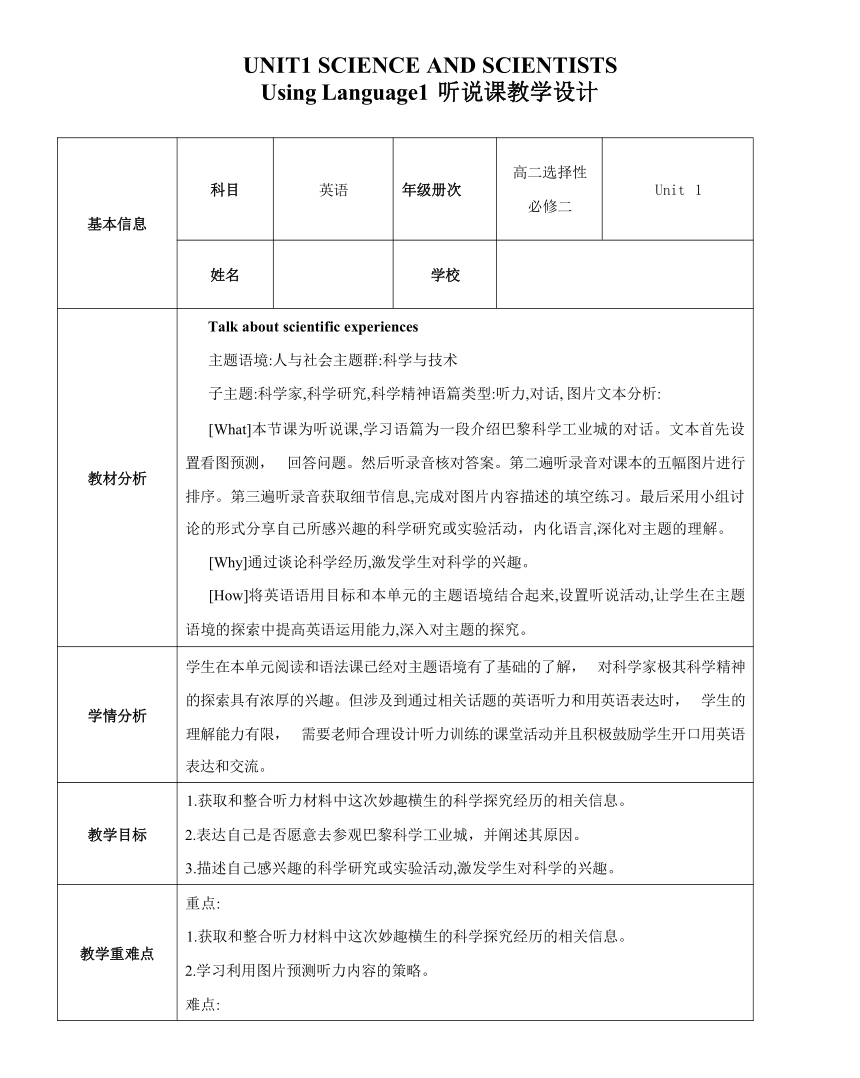
UNIT1 SCIENCE AND SCIENTISTS Using Language1 听说课教学设计 基本信息 科目 英语 年级册次 高二选择性 必修二 Unit 1 姓名 学校 教材分析 Talk about scientific experiences 主题语境:人与社会主题群:科学与技术 子主题:科学家,科学研究,科学精神语篇类型:听力,对话, 图片文本分析: [What]本节课为听说课,学习语篇为一段介绍巴黎科学工业城的对话。文本首先设 置看图预测, 回答问题。然后听录音核对答案。第二遍听录音对课本的五幅图片进行 排序。第三遍听录音获取细节信息,完成对图片内容描述的填空练习。最后采用小组讨 论的形式分享自己所感兴趣的科学研究或实验活动,内化语言,深化对主题的理解。 [Why]通过谈论科学经历,激发学生对科学的兴趣。 [How]将英语语用目标和本单元的主题语境结合起来,设置听说活动,让学生在主题 语境的探索中提高英语运用能力,深入对主题的探究。 学情分析 学生在本单元阅读和语法课已经对主题语境有了基础的了解, 对科学家极其科学精神 的探索具有浓厚的兴趣。但涉及到通过相关话题的英语听力和用英语表达时, 学生的 理解能力有限, 需要老师合理设计听力训练的课堂活动并且积极鼓励学生开口用英语 表达和交流。 教学目标 1.获取和整合听力材料中这次妙趣横生的科学探究经历的相关信息。 2.表达自己是否愿意去参观巴黎科学工业城,并阐述其原因。 3.描述自己感兴趣的科学研究或实验活动,激发学生对科学的兴趣。 教学重难点 重点: 1.获取和整合听力材料中这次妙趣横生的科学探究经历的相关信息。 2.学习利用图片预测听力内容的策略。 难点: 使用恰当的语言描述自己感兴趣的科学研究或实验,激发学生对科学的兴趣。 教学资源 多媒体;学案;黑板;粉笔 教学活动设计 Enjoy a video:What can you see in the video Free talk Can you tell us more amazing scientific phenomena 1.Look at the photos below,and discuss in groups what these activities have to do with science. What kind of place can it be in the pictures What does it focus on What kinds of things can you do there 2.The photos above are related to the conversation you will hear.Using the photos,try to predict the answers to the following questions. Predict by using pictures One way to get more out of your listening is to predict what you will hear.Using the pictures provideded the knowledge you already have,you can guess the kinds of information you should listen for.At times,you may even be able to guess exactly what will be talked about.This will help you focus better when listening,making your listening more effective. Where are the people in the conversation going to go What kind of place is it,and what does it focus on What kinds of things can you do there 3. Listen to the conversation and see if your answer for Activity2 are correct.Then write down the letters (A-E)for the photos in order that you heard them described. 4.Listen again and complete the descriptions of the photos above. Picture A: A giant dish; when you speak into it, it the sound back and . You can use it to speak in a to someone 17 metres away. Picture B: A giant that you can use your feet to play. Instead of playing the sounds of a piano, it plays the voices of . Picture C: You look at a blue screen for a while, and then suddenly you can see moving around on it. These are our . Picture D: A where you can see your ... ...
~~ 您好,已阅读到文档的结尾了 ~~

